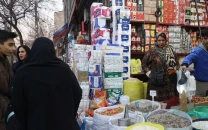'Things have not changed': Mother of gang rape victim backs India's rank as 'most dangerous for women'
India tops survey of 548 experts in women's issues

The Ministry of Women and Child Development said the survey
was an effort to "draw attention away from real improvements
seen" after the December 2012 attack. PHOTO: AFP
India topped the survey of 548 experts in women's issues due to the perceived high risk of sexual violence and slave labour faced by women, while war-torn Afghanistan and Syria ranked second and third followed by Somalia and Saudi Arabia.
The Ministry of Women and Child Development on Wednesday
dismissed the survey as "an effort to malign the nation".
But Asha Singh, the mother of the 23-year-old woman whose
death in December 2012 triggered global outrage and led to
tougher laws against sexual abuse in India, said the poll should
serve as a "reminder that things have not changed for women".
India most dangerous country for women with sexual violence rife: poll
"Every day, not even every day but every hour, an innocent
girl, a woman gets raped here," Singh told the Thomson Reuters
Foundation.
"I see truth in this survey. There is always a lot of talk
but never any real stringent steps taken for women's security.
Neither in terms of justice nor preventive action." The survey - that repeated a similar poll in 2011 in which India was ranked fourth - has reignited debate over the safety of women and protection of their rights, dominating newspaper and television news headlines in India.
The Ministry of Women and Child Development said the survey
was an effort to "draw attention away from real improvements
seen" after the December 2012 attack.
"Ever since the unfortunate incident of 2012, the entire country has been alert about the safety of women and ensuring their equality at home, in the economy and in society at large," the ministry said in a statement.
GOVERNMENT ACTION
"The ranking of India is a surprise and clearly inaccurate."
The ministry had earlier declined to comment on the survey
results.
The National Commission for Women also rejected the poll
that was released on Tuesday, saying it was "not representative
of the country" of 1.3 billion people. Earlier this year India approved the death penalty for the rape of girls under 12, and increased the prison term for the rape of older girls and women following nationwide disgust over the rape and murder of a Muslim girl in Jammu & Kashmir state.
Singh, however, urged the government to look again at the issue and fix a creaking criminal justice system, which she says has kept her daughter's attackers - convicted and sentenced to death - alive.
"The government can choose to reject the poll or accept it
but it must think about why this kind of situation is still so
rife and why these kinds of surveys are being done," she said.
"They can say 'no, India is absolutely safe for women' but
what about those victims of rape, sexual assaults? Will they be
able to say the same?" Government data shows reported cases of crime against women rose by 83 percent between 2007 and 2016, when there were four cases of rape reported every hour.
The survey asked respondents which five of the 193 United
Nations member states they thought were most dangerous for women
and which country was worst in terms of healthcare, economic
resources, cultural or traditional practices, sexual violence
and harassment, non-sexual violence and human trafficking.
Respondents also ranked India as the most dangerous country
for women in terms of human trafficking, including sex slavery
and domestic servitude, and for customary practices such as
forced marriage, stoning and female infanticide.



















COMMENTS
Comments are moderated and generally will be posted if they are on-topic and not abusive.
For more information, please see our Comments FAQ